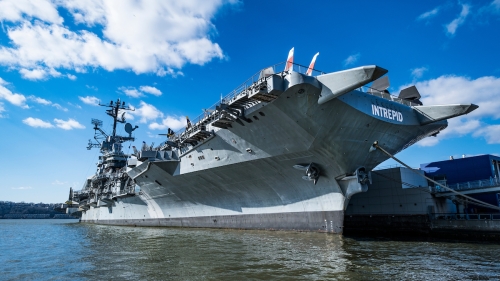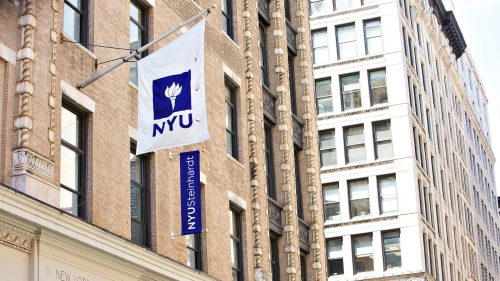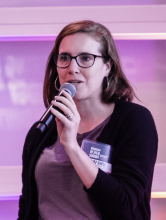Through a new grant, the Museum will partner with the NYU Ability Project to create experiences that are accessible to visitors with disabilities.

Photo courtesy of the Intrepid Sea, Air & Space Museum.
Creating a space to support people with disabilities takes more than just adding an elevator or ramp – especially if looking beyond the inability to walk or when considering historic sites like the Intrepid Sea, Air & Space Museum where certain reconstruction may be impossible. With the help of a new grant from the Institute of Museum and Library Services (IMLS), the NYU Ability Project, an interdisciplinary research space dedicated to studying the intersection between disability and technology, is partnering with the Intrepid Museum to explore opportunities for people with disabilities to enjoy these sites just the same as people without.
“This project has the potential to drastically improve the museum experience for millions of individuals with disabilities,” said NYU Ability Project Director and Associate Professor of Accessibility and Human-Computer Interaction Amy Hurst. “We are thrilled to embark on this exciting collaboration with the Intrepid Museum to deeply understand the unique accessibility challenges historic sites and museums encounter, and develop techniques that can be adopted at other cultural institutions around the world.”
“We are fortunate to be working with NYU’s Ability Project on this groundbreaking IMLS National Leadership project,” said Elaine Charnov, Senior Vice President of Exhibits, Education & Programs, and NYU graduate. “Almost half the museums in the United States are historic sites, historical societies or historic preservation organizations. The very features that make those venues evocative often present challenges for the more than 40 million Americans with disabilities. All of us strive to be even more welcoming. We believe that bringing talents together, blending theory and practice, and getting creative students involved will help to innovate creative solutions.”
The Plan for the Project
The goal of the project is to produce a digital publication, titled Sensory Tools for Interpreting Historic Sites, that offers concrete strategies to increase visitor engagement at museums of all sizes, while supporting attendees with a wide range of physical, sensory, cognitive, or behavioral abilities. The publication will be presented and circulated widely to the historic site community.
To begin, the Intrepid Museum and the NYU Ability Project will establish a core working group of eight local individuals with varying disabilities and eight professionals representing historic sites across the United States. The working group will listen to some of the identified challenges from the eight historic sites, which represent a variety of environments – including historic houses, gardens, and ships – with the goal of exploring solutions.
“This project will bring together experts from various constituencies so that our approach to increasing accessibility in museums and landmark locations is comprehensive,” said Anita Perr, Clinical Associate Professor of Occupational Therapy at NYU Steinhardt and principal investigator on the project. “By leaving important players out, we run the risk of missing obstacles which can lead to the omission of important facilitators to access. Our goal is to do the opposite and bring everyone to the table. We are excited to learn from the core working group and to have their input and collaboration throughout the design and development process.”
During the spring 2020 semester, New York University will offer a graduate-level course on developing assistive technology for these eight museums and historic sites. The course, co-taught by Hurst and Perr, will take ideas from the focus group and give students the opportunity to explore prototypes as solutions to some of the accessibility challenges faced at the historic sites. The solutions will include new and emerging technologies that leverage augmented and virtual reality, digital fabrication, and microcontrollers. The prototype solutions will be exhibited at the Intrepid Museum and included in the digital publication.
One example challenge the working group may explore is providing access to the engine room on the Intrepid, a decommissioned aircraft carrier that served from World War II through the Vietnam War Era. The engine room on the aircraft carrier is about five stories down, through several corridors, and only accessed by steep ladders. Depending on a person’s physical and sensory abilities, this walk may be impossible. Additionally, any reconstruction would take away from the authentic nature of the historic landmark. One possible solution may include using technology to create a virtual or physical 3D replica of the room in an area that is more accessible. Problems like this will challenge the working group to be creative and develop solutions that serve not only the Intrepid Museum, but potentially, hundreds of sites across the country.
The NYU Ability Project and the Intrepid Museum began discussing this partnership in April 2018. Both entities noticed the evolving needs and trends in the museum field, and wanted to contribute in a big way.
In 2017, NYU Ability Project also collaborated with Cooper Hewitt Smithsonian Design Museum to make its offerings more accessible to guests with disabilities. Learn more about this project here.

About the NYU Ability Project
The Ability Project is an interdisciplinary research space dedicated to the intersection between disability and technology.


